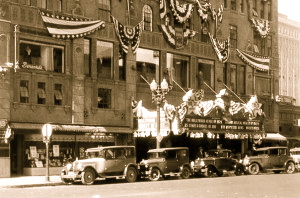California Theatre

California Theatre: Historical Gem or Pile of Rubble?
An old abandoned building in the heart of downtown used to be one of San Diego’s most elegant theaters. It’s been empty since 1990 even though plenty of developers have shown interest in buying it. KPBS culture reporter Angela Carone looks at the past, present and uncertain future of the California Theatre.
 Now the California Theatre, 1122 Fourth at C Street, San Diego
Now the California Theatre, 1122 Fourth at C Street, San Diego
The New California Theatre was one of the last two old movie palaces (Balboa being the other) . When opened in 1927, it was heralded as “the cathedral of the motion picture” and “an enduring contribution to the artistic beauty of the entire Southland”. Ceilings were gold leaf, murals were scattered throughout the theatre. A huge Wurlitzer organ was installed. The theatre had a seating capacity of 2200. The Aztec Theatre on Fifth was built in 1905 as a meat market and entered the show business in 1919 as the California Theatre — it became the Aztec in 1930, allowing the New California Theatre to drop the “New.”
The New California Theatre was owned by the West Coast Theatres and backed by San Diegan C. S. Judson. At its grand opening on April 22, 1927, the theatre presented Constance Talmadge and Antonio Moreno in “The Venus of Venice”, Fanchon and Marco’s “Book ideas”, and Al Lyons and his band. Bernard’s Inc., an apparel store for women, occupied the entire second floor in 1927. Movies were discontinued in 1976, but the theatre was available for special performances.
The architecture is Spanish Colonial Revival and combines theatre, shops, and office in a three-level, reinforced concrete structure. The nine-story portion faces Fourth Avenue and incorporates theatre entrance and offices. The proscenium area is six stories and the auditorium almost five stories. The parapets of the flat roofs have red tile trim, decorated cornices and dentils or arched corbeling. Bands of cast ornamentation continue around the building at various levels and are trimmed with urns. Some windows have arches and baroque surrounds.
The side walls of the auditorium imitate a Spanish church. The “C” Street wall of the rear has a sign painted on it. On the office section, the windows are recessed and plain in style from the fifth floor upwards. A small penthouse is on the north side of the roof. The marquee faces Fourth Avenue. Cement quoins marking the corners of the first three floors include niches for statuary.
The Old Globe Theatre used the California Theatre downtown while its Balboa Park home was rebuilt after the 1978 arson fire.
A 1988 renovation of the building restored much of the appearance of the 1920s. The marquee “circus” box office was removed, new carpeting was installed, and the ornate sculptural decorations were restored. There were some changes made in the marquee. The building appears much as it did when built.
The building was scheduled for demolition in the summer of 1990 but is still standing in 2000. The Wurlitzer organ was moved to Trinity Presbyterian Church in Spring Valley, but in March of 1996, an arson fire destroyed the organ console and most of the pipework.
http://www.sandiegohistory.org/collections/theaters/california.htm

